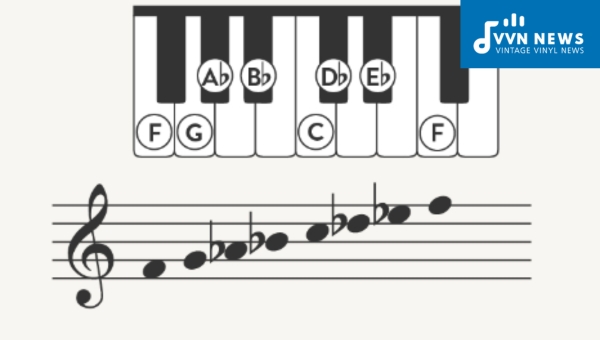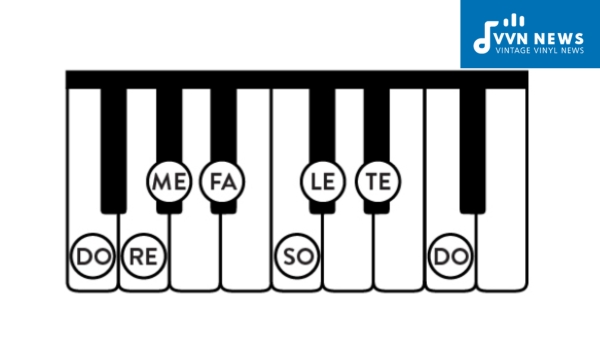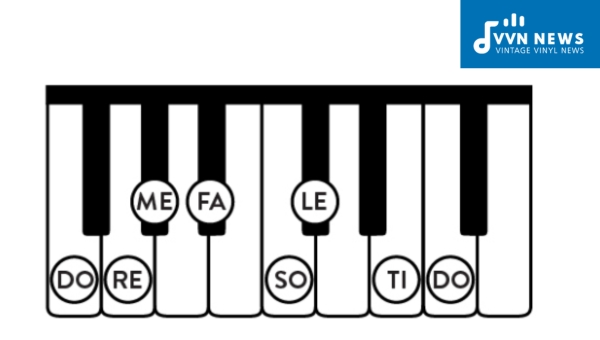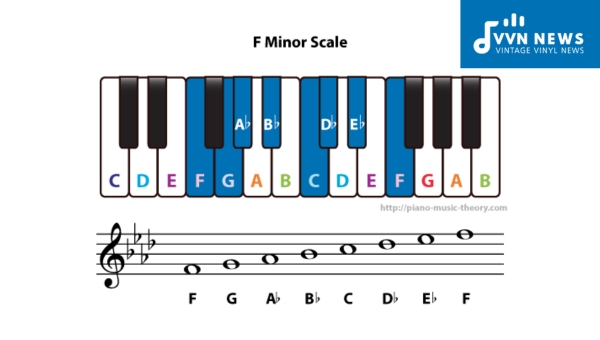If you’ve ever played a musical instrument or even simply tapped your foot along to the beat of your favorite song, you’ve engaged with the wonderful world of music scales.
Just as our alphabet is the backbone of our written communication, scales work as a foundational element guiding music’s rhythm, style, and emotion.
Today I want to guide you through a fascinating yet often overlooked musical scale – The F minor scale.
This scale can bring forth immense color and dimension in composition and performance alike.
Often overlooked in favor of its major counterparts, no other scale quite captures melancholy sentiments as the F minor scale does.
As we journey into the notes within this dynamic tune today, I aim to provide you with deep insights into the beauty it holds.
What is the method for constructing the F Minor Scale?
Creating the F minor scale involves adhering to a specific pattern of intervals.
This distinct arrangement is what gives the scale its unique and remarkably emotive sound.
Here’s how you do it: Start on note F. From here you will follow a sequence of whole steps (W) and half steps (H).
A ‘whole step’ refers to two half steps, or in other words, skipping one key immediately next to your starting note on a piano keyboard.
The pattern for minor scales is: W – H – W – W – H – W – W
Let me break this down:
- Start with an F note.
- From F, move a Whole step to reach your second note, which is G.
- Proceed with a Half step from G, landing you at an Ab.
- Continue with a Whole step from Ab, guiding you to your fourth note, which is a Bb.
- Another Whole step from there brings you to your fifth note, which is C.
- Keep going strong with another Half step from C, which leads you to your sixth note of the scale, namely a Db.
- Finally, take another Whole step from there to get yourself back home at F.
By sticking to this combination of whole steps and half-steps, our musical journey lands us back on an F Note thus defining the melodious sequence that forms the spine of the F minor Scale.
What degrees make up the F Minor Scale?

Our exploration of the F minor scale begins with an knowledge of its degrees or steps.
As with any music scale, this scale features seven unique notes each associated with a specific degree.
A Closer Look at Each Degree
- The First Degree: Known as the Tonic or the keynote, it is ‘F’ and serves as our starting point.
- The Second Degree: aptly named the Supertonic, it falls on ‘G’.
- The Third Degree: Also referred to as the Mediant, it is ‘Ab’ (A flat).
- The Fourth Degree: Known as the Subdominant, ‘Bb’ (B flat).
- The Fifth Degree or the Dominant lands us on ‘C’.
- The Sixth Degree, referred to as the Submediant, stands at ‘Db’ (D flat).
- Finally, we reach the Seventh degree or Subtonic, which ends on ‘E’.
Each degree in this progression builds upon one another to contribute a unique frequency and pitch to this blend.
Accordingly, mastering their sequence allows you to play an intricate role in crafting your very own engaging harmony using this fascinating minor scale.
Also Read: F Sharp Minor Pentatonic Scale [How To Use In Your Compositions]
How to play the F Minor Scale on piano and guitar?
Learning music scales isn’t a small feat. It’s often a regular part of any musician’s life and is essential to enhance your performance.
If you’re looking to conquer the F Minor scale, you’ve landed in the right place.
This wonderful sound, often associated with powerful and emotive ballads, will captivate listeners right away.
Playing the F Minor Scale on Piano
The process of playing the F minor scale on piano involves a specific sequence of steps that guarantee smooth transitions between notes. Here are detailed instructions:
- Start from the F key, which is located in the cluster of three black keys, between the first and second black keys.
- Follow with G. It’s just next to the F key on its right side.
- The next note is Ab. You will find it directly next to G but it’s a black key (the first one in a group of three).
- The next note is Bb, another black key, found on your right side adjacent to Ab.
- Move onto C directly after Bb, followed by D, these are white keys.
- The final two notes in our series are Eb (black) and F (white).
In terms of fingering for this series: 1-2-3-4-1-2-3 for the Ascending order path and the descending path: 3-2-1 then stretch your hand a little bit to use finger 4 on Eb; followed by 3-2-1 for D-C-Bb; finally again stretch your hand to play Ab with finger number 4.
Strumming the F Minor Scale on Guitar
Starting with the F minor scale on guitar might be a bit intimidating for novices, but it gets straightforward with practice. Just follow these steps:
- Locate the F note in the 6th string of your guitar – this is where our scale will originate.
- Play the G note right after it with your third finger.
- The next step is Ab, played by stretching your pinky on the 4th fret.
- Quickly switch to Bb located on the second fret of the 5th string, utilizing your index finger.
- Press onto C with your middle finger on the 3rd fret and D through elongating your pinky to the very next fret on the 5th string.
- To play Eb, relocate your index finger on the first fret of the fourth string and conclude with F played by using your ring finger on a third fret.
Repetition breeds proficiency and consistency is key to mastering any musical scale.
So don’t be disheartened if you don’t manage to perform it flawlessly at first.
How is the F Minor Scale shown in different clefs?

In the realm of music, clefs are invaluable notation tools that indicate the pitch of written notes.
They serve as guides, marking a specific line on the staff as a particular pitch.
Clefs are critical when it comes to reading and interpreting musical pieces accurately, and therefore observing scales across different clefs can offer new insights.
Take the F minor scale – it looks different in four main clefs: treble, bass, tenor, and alto.
Treble Clef
The F minor scale, like all scales, can be transcribed in several ways depending upon the instrument it is written for.
The treble clef, or G clef, is most frequently utilized by high-range instruments like the violin and guitar, as well as the right hand on keyboard instruments.
The key signature of F minor contains four flats: Bb, Eb, Ab, and Db. In the treble clef, it appears as follows
F – G – Ab – Bb – C – Db – Eb – F.
Also Read: How To Transpose Treble To Bass Clef [Music Guide]
Bass Clef
The bass clef, commonly referred to as the F clef, is typically written for low-range instruments such as the cello or double bass, not to mention the left hand on keyboard instruments.
This key’s notation is identical to that of the treble clef but starts from a different position. In bass clef, you will observe this pattern:
F- G- Ab- Bb- C- Db- Eb- F.
Also Read: How To Transpose Bass Clef To Treble Clef [A How-To Guide]
Tenor Clef
Instruments like the viola and trombone commonly use tenor clef in their higher ranges and it is also often used by cellists.
It’s written similarly to both bass and treble clauses but on a middle range. The F minor appears in tenor clef like so:
F – G Ab – Bb – C – Db – Eb – F.
Also Read: How To Transpose Into The Tenor Clef? [Mastering In Notation]
Alto Clef
As a fairly niche musical notation system utilized by specific mediums including viola music or orchestral scores —for its central range — alto cleff may feel somewhat exotic compared to its more prevalent kinfolk.
It’s just another way musicians communicate their ideas across diverse tonal domains when portraying an F minor key — its display will mirror all other staves we have discussed earlier by maintaining their specific written patterns.
While this may seem somewhat complex at first, with regular practice and time, these annotations can become as second nature to musicians as reading written text is to an author.
Certainly, mastery of these elements should be considered an essential skill for anybody aspiring towards music literacy.
Also Read: A Guide Transposing Into The Alto C [Navigate Music Transposition]
What key signature is associated with the F Minor Scale?
The F minor scale is notably recognized by its unique key signature. This consists of four flats, namely: B, E, A, and D.
These flats are universally harmonious to each melody composed in this particular scale.
It’s crucial to comprehend that the key signature doesn’t merely indicate which notes are flat or sharp; instead, it outlines the underlying harmony of compositions and characterizes the tonal center of the music.
The F minor scale’s compelling nature is greatly defined by this distinctive arrangement of tones.
Let’s next detect how these tones precisely coordinate on piano and guitar, illustrating an effective transition.
What is the Relative Major Key of the F Minor Scale?

For every minor scale, there exists a relative major that shares the same key signature.
This interlinked relationship provides greater flexibility and exploration in composition.
In the case of F minor, its relative major is A-flat Major (Ab). It’s a straightforward calculation.
Begin from your root note, or F, and count up six scale degrees (Include the root note in your count).
So, in F minor: F (1), G (2), Ab,(3) Bb (4), C(5), Db(6). It lands us on Db – the relative major of F minor.
What are the component chords of the F Minor Scale?
The F Minor scale is made up of seven distinct notes, resulting in the formation of 7 main chords when built off each note in the scale. These are:
- F minor: Denoted by (F – Ab – C)
- G minor: The second chord composed of (G – Bb – D)
- Ab major: Third, made up from (Ab – C – Eb)
- Bb minor: Fourth containing (Bb – Db – F)
- C minor: Fifth with (C – Eb – G)
- Db major: Sixth comprising of (Db – F – Ab)
- Diminished E: The seventh and final chord is typically expressed as (E – G- Bb)
Notice that the first, fourth, and fifth chords are minor, while the third and sixth are major, which gives the F Minor scale its characteristic emotional depth and complexity.
The diminished E backs up this melancholy mood too.
Using these component chords can infuse your music with a depth and texture that’s uniquely associated with the F Minor Scale.
FAQs About The F Minor scale
What is special about the F Minor Scale?
The F minor scale is known for its melancholic and emotional resonance; it’s often used in music to evoke deeper feelings and portray sadness or desolation.
Why should I learn the F Minor Scale?
By learning the F minor scale, you enhance your musical vocabulary and gain skills to express complex emotions musically.
Who are some famous composers who used the F Minor Scale?
Several renowned composers, such as Beethoven and Schubert, frequently used the F Minor scale in their works to create stirring compositions.
What is the harmonic version of the F Minor Scale?
The harmonic version of the F minor scale ascends as per a normal minor scale but has a raised 7th degree (E natural instead of Eb) when descending.
Can beginners learn to play the F Minor Scale easily?
Certainly! While it may take practice, beginners can learn to play the F-minor scale on various instruments like piano and guitar.
Conclusion
In the grand scope of music theory, mastering the F minor scale gives you a powerful tool that could be your gateway into truly emotional and expressive music.
From its signature dark yet somberly beautiful tone to its versatile use in piano ballads and guitar solos, the journey through these seven captivating notes is truly rewarding.
I encourage you to continue exploring this unique sonic landscape that holds vast potential for enriching your musical knowledge and skills.








